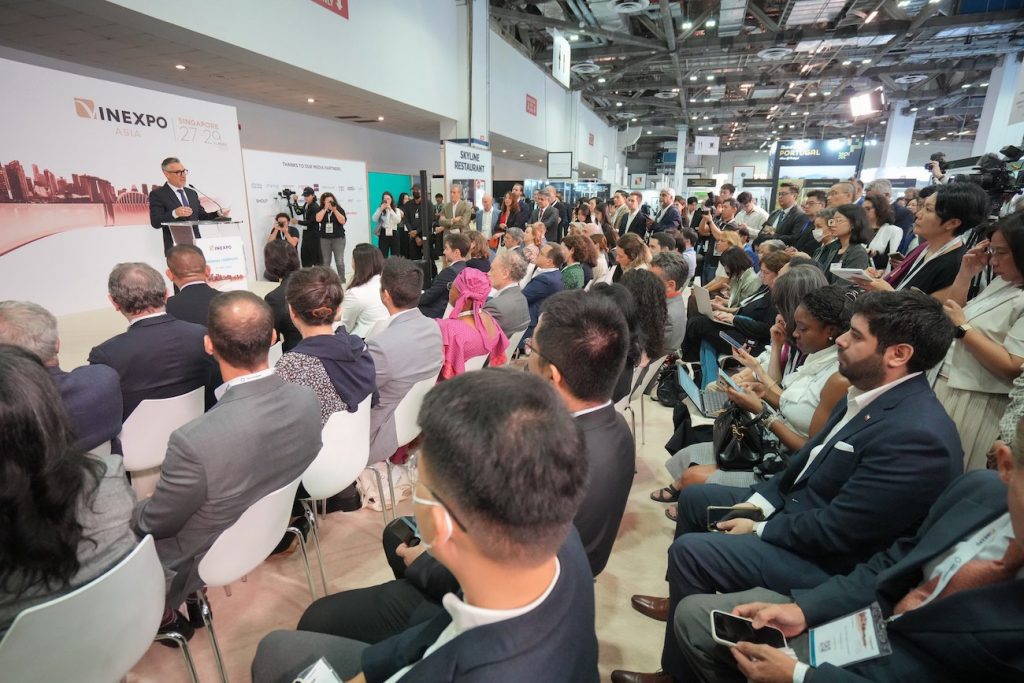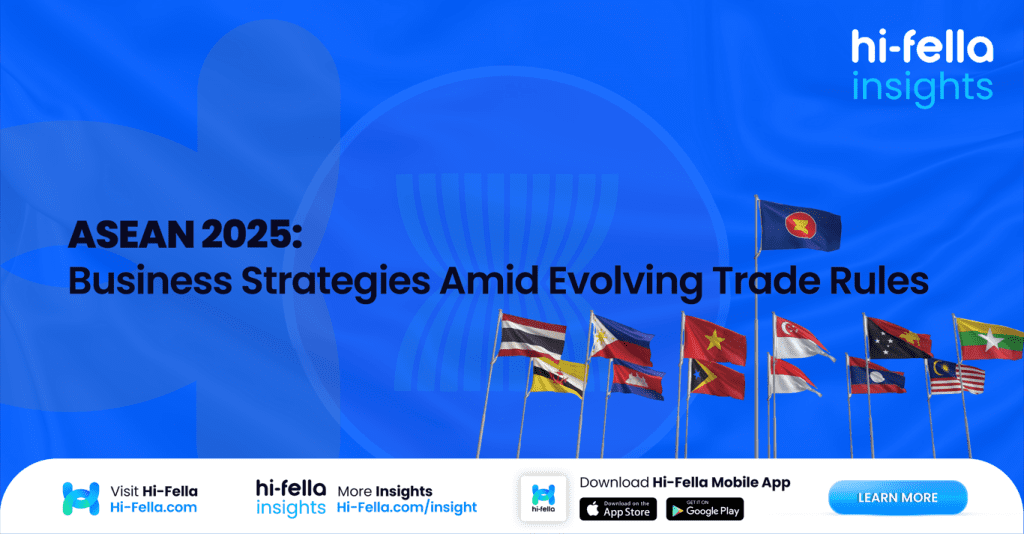The ASEAN region stands at a turning point in global trade. With rapid digitalisation, regional integration, and renewed economic agreements, businesses operating in Southeast Asia face both new opportunities and heightened complexities. From the Regional Comprehensive Economic Partnership (RCEP) to local compliance shifts, traders must recalibrate their strategies for a smarter, faster, and more resilient future.
As global and regional players adjust their sourcing, production, and compliance playbooks, platforms like Hi-Fella offer the intelligence and infrastructure to stay ahead — through verified supplier connections, regulatory insights, and real-time trade tools tailored for ASEAN’s dynamic market.
Understanding the Shifting Trade Landscape in ASEAN Post-2023

ASEAN’s trade architecture is undergoing structural change. Driven by the implementation of RCEP — the world’s largest free trade agreement — alongside an upgraded ASEAN Trade in Goods Agreement (ATIGA) and digital economy frameworks, the region is moving toward greater liberalisation and connectivity.
Key developments shaping the ASEAN trade landscape include:
1. RCEP (Regional Comprehensive Economic Partnership)
The RCEP agreement, signed by 15 Asia-Pacific countries, is designed to reduce tariffs, streamline customs procedures, and improve market access across the region. It simplifies trade by harmonizing rules of origin, which allows products made with components from multiple RCEP countries to qualify for preferential tariffs. This is particularly advantageous for regional supply chains and integrated manufacturing hubs.
Countries like Vietnam, Indonesia, and Thailand are poised to benefit significantly due to their growing industrial bases and strategic locations. By enjoying lower tariffs and fewer regulatory hurdles, these countries can attract more foreign direct investment (FDI) and expand exports. RCEP also helps local businesses become more competitive in international markets by reducing input costs and encouraging regional production networks.
2. EVFTA (EU-Vietnam Free Trade Agreement)
The EVFTA is a landmark deal between the European Union and Vietnam that eliminates 99% of tariffs over a transition period and provides stronger protections for intellectual property, labor rights, and sustainable development. For Vietnam, this agreement enhances its access to the lucrative EU market, opening up opportunities for exporters in key sectors such as electronics, textiles, footwear, and agricultural goods.
Vietnam stands out among ASEAN members as a major beneficiary, positioning itself as a gateway for EU businesses into Southeast Asia. The agreement strengthens Vietnam’s appeal as a manufacturing hub by offering competitive labor costs and preferential trade terms with Europe. This boost in trade potential can drive industrial growth, create jobs, and enhance Vietnam’s reputation as a reliable global supplier.
3. China+1 Strategy
The China+1 strategy reflects a growing trend among multinational companies to diversify their manufacturing operations by setting up additional production bases outside of China. This approach is primarily driven by the need to mitigate risks from geopolitical tensions, rising labor costs in China, and disruptions such as COVID-19 or trade disputes. ASEAN countries are emerging as the top alternatives due to their proximity, favorable trade agreements, and improving infrastructure.
Nations like Vietnam, Indonesia, and Malaysia have become popular “plus-one” destinations thanks to their skilled labor, government incentives, and integration into global supply chains. This shift benefits ASEAN by bringing in new investments, expanding employment, and boosting export capacity. For global companies, this diversification also enhances resilience and cost efficiency across their supply networks.
4. Customs Reforms
Modernizing customs procedures is becoming a priority across ASEAN, with countries like the Philippines and Indonesia leading efforts to digitize clearance processes. These reforms include implementing electronic documentation, real-time tracking, and automated risk assessments to reduce bureaucratic delays. The goal is to enhance transparency, speed, and reliability in cross-border trade.
By adopting digital customs systems, these countries are improving their ease of doing business, reducing corruption, and cutting logistical costs for exporters and importers. Faster clearance times make their ports more competitive and attract more global trade. For local businesses, this means fewer administrative burdens and quicker access to international markets, ultimately supporting broader economic growth.
For traders and manufacturers, understanding these shifts is essential for optimizing tariff utilization, supplier selection, and investment timing.
The Role of Regional Integration and Intra-ASEAN Trade Growth
Intra-ASEAN trade continues to rise, fuelled by both policy coordination and digital infrastructure. In 2023, ASEAN intra-regional trade reached over US$850 billion, accounting for nearly 22% of total ASEAN trade, and is expected to climb further with initiatives such as:
- ASEAN Single Window (ASW): A digital platform enabling quicker customs clearance and cross-border document exchange across ASEAN member states.
- Cross-border e-commerce: Accelerated by pandemic-era shifts, firms are now sourcing and selling directly across borders via digital platforms.
- Regional logistics optimization: Firms are now establishing multi-node supply chains across Vietnam, Malaysia, and Indonesia to benefit from tariff preferences and reduced logistics risks.
Businesses that tap into this integration are relocating or diversifying operations not just for cost — but for speed, compliance ease, and proximity to end markets.
Mitigating Regulatory Risks: Key Compliance Trends to Watch
ASEAN’s regulatory environment is also evolving rapidly. While harmonisation is increasing, country-specific compliance remains crucial. Key developments include:
- ESG trade compliance: New EU carbon regulations and consumer expectations are pressuring ASEAN exporters to adopt greener practices.
- Halal and product certifications: Malaysia mandates stricter halal documentation; Indonesia’s DPP law requires detailed import/export traceability.
- Singapore’s sustainability rules: New ESG reporting standards apply to exporters in logistics, energy, and food sectors.
- Digital trade documentation: E-certificates and blockchain integration are becoming part of standard customs procedures.
Amid rising geopolitical tensions — including US-China decoupling — ASEAN firms are under pressure to maintain multi-market compliance readiness. Platforms like Hi-Fella help navigate this complexity by embedding regulatory updates into sourcing tools and trade dashboards.
Strategic Responses by Global and Local Firms in ASEAN
Global and regional firms are already taking action. Their strategies are instructive for businesses looking to thrive in ASEAN’s shifting trade regime:
- Apple is expanding its iPad assembly in Vietnam, illustrating the shift from China-centric production.
- Singapore-based firms are investing in green logistics and sustainable ports to align with EU and Japan import standards.
- Malaysian SMEs are integrating blockchain to automate certificate management and ensure halal compliance across multiple markets.
- Thai agritech exporters are using AI to forecast crop demand and negotiate smarter trade contracts.
These firms are leveraging multi-shoring, vertical integration, and predictive market intelligence — trends that Hi-Fella enables through smart supplier discovery, integrated compliance data, and regional insight feeds.
Join Hi-Fella Today!
Preparing for ASEAN 2025 requires more than just reactive adaptation — it requires proactive strategy built on trusted data, timely insights, and flexible trade networks. Hi-Fella equips you with all three.
With Hi-Fella, you can:
- Connect to verified ASEAN suppliers with region-specific documentation and credentials
- Track regulatory updates from across Southeast Asia and integrate them into sourcing workflows
- Use private showcases and digital trade tools to simplify negotiations and risk assessment
- Align your supply chain with ASEAN trade agreements and real-time logistics intelligence
Whether you’re optimizing sourcing from Vietnam, launching in Indonesia, or shifting fulfillment to the Philippines, Hi-Fella is your partner in navigating the future of ASEAN trade.








